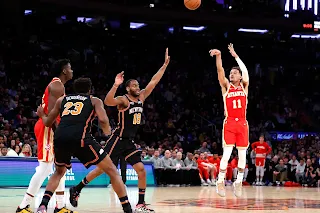Is Today’s NBA Really Just a “Make-or-Miss” League After All?
I’ve read somewhere or other that there was a ballgame early in the brief but impactful lifetime of the old American Basketball Association with a rather clumsy conclusion. A team trailing by two points in the waning seconds hit a buzzer beater. As the squads began to gather for OT prep, it finally “dawned on” someone that, because of this new league’s new-fangled rules, such a long-distance “heave” was worth not TWO but THREE points and the game was over!
But just what measurable component(s) of competitive hoops
at its most elite level are most impactful to the outcome?
Was Pat Riley truly prophetic decades ago when he preached “No
Rebounds, No Rings”?
To what extent do the “zebras” and their whistles influence
things?
At its essence, success on the basketball court – whether played
on a concrete schoolyard or on the Gahden’s storied parquet – is rather simple.
Take care of the ball, take and make good shots, get your fair share of
rebounds, make it tough for your opponent to do the same.
So I figured the NBA Playoffs – the NBA Finals specifically
– would classify as the sport at its most elite and competitive. Are not, for
instance, many coaches prone to shorten their playing rotations from round-to-round
(if not game-to-game), entrusting the outcome to only those they deem most capable?
What is it, then, that has separated the winners from the
losers during the 58 Finals games conducted over the past decade, since LBJ and
Ray Allen snatched victory from defeat against Pop’s Spurs in 2013, through
GSW’s current fourth reign in six Finals tries since.
In his seven Finals appearances over that span, Mr. James
won three titles – each with a different franchise. (Cleveland reached four
Finals, Miami three, San Antonio two, and Toronto, the Lakers, Milwaukee, Phoenix
and Boston one apiece.)
During this decade of championship chases, the winning side
connected on four or five more field goals per game (40.3 -35.6), about half of
that edge comprised of three-pointers (12.6-10.3). Surprisingly, the losers
attempted marginally more free throws (22.4-22.1) but made 40 fewer overall. Field
Goal Attempts were relatively even, winners taking not quite one more shot per
game (83.7-83.0) and nearly two more treys (31.6-30.1).
Less surprising is that the vanquished recorded 62 more “second
chances” – when we include significant Offensive TEAM Rebounds – while the
victorious were +152 on the defensive glass (again including the Team
Rebounds).
Also unsurprisingly, the winning side takes better care of
the ball, committing two fewer Turnovers each game.
But the numbers that stand out most glaringly are the
Shooting Percentges – the winning side shoots 50+ points more effectively, .482
- .428 overall and .399 - .341 from behind the arc. The regular-season league
averages for that stretch ranged from .449 (’14-15) and .466 (’20-21), and from
.350 (’14-15) and .367 (’20-21) for three-balls.
Make-or-Miss, indeed!
Here’s a composite look at the numbers from those 58
contests:
2013 thru 2022 NBA Finals (58 games)
Winning Team / Losing
Team
Points: 6424 (110.8 pg) / 5693 (98.2 pg)
Possessions: 5431 (93.6 pg) / 5422 (93.5 pg)
Conversions: 2908 (.535) / 2625 (.484)
FG: 2340-4856 (.482) / 2062-4815 (.428)
3FG: 731-1834 (.399) [.378, 3PAr] / 596-1746 (.341) [.363, 3PAr]
FT: 1013-1282 (.790) [568 conv.] / 973-1297 (.750) [563 conv.]
OR: 549 (+178 Team) [.239, OR%] / 623 (+166 Team) [.244, OR%]
DR: 1933 (+99 Team) / 1752 (+128 Team)
TO: 695 (+39 Team) [.119, TO%] / 804 (+49 Team) [.137, TO%]
Abacus Revelation for the Road
The most glaring change to NBA play over the last decade has
been the explosion in the usage of the three-point stripe – the league
attempted SEVENTY-FIVE PERCENT more treys in 2021-22 (2885 per team, .399 3PAr)
than in 2012-13 (1636, .243). That’s 15 more long balls per team, every game.
The court-spacing that has evolved from this acceleration in
three-point shooting is largely responsible for DeAndre Jordan becoming the
first “qualified” player to post a .700+ FG% (in 2014-15) since Wilt’s final
season (.727 in 1972-73).
Rudy Gobert topped the circuit in accuracy from the field
last season at .713.
Boston’s inconsistently available big man Robert Williams
III has shot .728 over his four-year career – but has never qualified for
inclusion among the league leaders.








 alt="" data-uk-cover="" />
alt="" data-uk-cover="" />
















